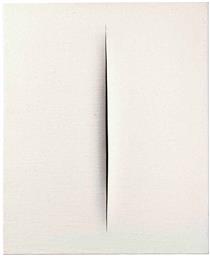1940
Spatialism

description
Spatialism
Spatialism was an art movement that was founded in Italy in the 1940s, as a collaboration of painting and sculpture.
The founder and author of the term was Lucio Fontana (“Manifesto tecnico dello Spazialismo”, 1947).
The preamble of the movement is Lucio Fontana’s confident cut on an untreated canvas. However, in general, this is only a small component in the art of the twentieth century, with the help of which the genius, injuring the “Black Square”, looked outside the picture space, behind which a new semantic concept was hidden.
Works of Spatialists are combinations of Concrete art, Tashism, Dada, Minimalism, interest in scientific progress and the search for new media in painting.
Techniques: oil, canvas, paper, plasticine, wood, metal, fabric, readymade, etc. Genres: abstraction, sculpture, installation.
Key ideas:
The fusion of painting and sculpture into something single, integral, multisemantic, underlined by colour, form, space.
The main task of Spatialism is to use the fine art to show the moment in time, the energy of the master’s movement, to convey the sounds and sensations of space; symbiosis of statics and dynamics to the contemplator.
The following elements are inherent in this art movement:
– cuts and scratches of different lengths on canvases and solid objects;
– punctures of different diameters, depths;
– torn holes on paintings, panels and solid objects;
– composition of solid objects, fabric or paper glued to the canvas;
– a combination of the layering of canvases and other surfaces at a certain distance one after another with round or oval holes to create spatial depth. The holes are centered or disordered;
– depression, or convexity of the canvas or other surfaces with the help of an auxiliary object, without its visibility;
– sculptures and installations, consisting of different materials. They can be unique, or consisting of readymade;
– electric light is used.
description
An Italian painter and sculptor, author of theoretical works on art. Lucio Fontana is considered the most radical artist after Kazimir Malevich, who managed to bring art to a new round of the development of abstraction and minimalism. The name of Fontana is associated primarily with his cut paintings: the artist unsparingly cut them with a sharp blade or pierced his canvas with a knife. But he did not intend to destroy his works. He just wanted to expand the pictorial space of his painting, to make them voluminous and evoking different associations.
February 19, 1899, Rosario, Santa Fe, Argentina - September 7, 1968, Comabbio, Lombardy. Italy
